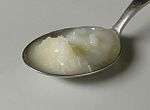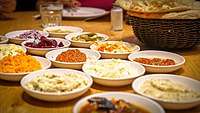Schmaltz
Schmaltz (also spelled schmalz or shmalz) is rendered (clarified) chicken or goose fat. It is an integral part of traditional Ashkenazi Jewish cuisine; where it has been used for centuries in a wide array of dishes such as chicken soup, latkes, matzah brei, chopped liver, matzah balls, and fried chicken, among others, either as a cooking fat, spread, or flavor enhancer[2][3].
 Schmaltz derived from geese | |
| Type | Spread, cooking fat |
|---|---|
| Region or state | Jewish communities in Central and Eastern Europe[1] |
| Created by | Ashkenazi Jews |
| Main ingredients | Fat (chicken or goose) |
| Nutritional value per 100 g (3.5 oz) | |
|---|---|
| Energy | 3,767 kJ (900 kcal) |
0 g | |
99.8 g | |
| Saturated | 30 g |
| Monounsaturated | 45 g |
| Polyunsaturated | 21 g |
0 g | |
| Other constituents | Quantity |
| Cholesterol | 85 mg |
| Vitamin E | 2.7 mg |
| Selenium | 0.2 mg |
Fat percentage can vary. | |
| |
| †Percentages are roughly approximated using US recommendations for adults. Source: USDA Nutrient Database | |
Chicken has historically been the most popular meat in Ashkenazi Jewish cuisine, due to historical restrictions on Jews who were often not allowed to own land in Europe on which to tend to livestock. Schmaltz originated in the Jewish communities of North, Central, and Eastern Europe as it was an economical replacement for olive oil which was typically not available in these areas, and which had an important role in Jewish culture and had been used by the ancestors of the Ashkenazi Jews in their cuisine prior to the forced exile of Jews from Israel, and remained popular in Sephardic, and Mizrahi Jewish cuisine[2][4][5]
Schmaltz was the most popular cooking fat used in the shtetls (Jewish villages) of Eastern Europe, and was commonly used in a multitude of dishes served with or containing meat in accordance with kosher dietary laws. As the Ashkenazi Jews fled escalating antisemitism and persecution in Eastern Europe and sought refuge in the United States and other countries at the turn of the 20th century, they brought with them their traditional foods including schmaltz, which remained popular in American Jewish cuisine for a time until it fell out of common use over the course of the second half of the 20th century due to the inconvenience involved in its preparation, health concerns regarding its saturated fat content, various diet trends, and aggressive marketing to the Jewish community of New York by Crisco over time and was replaced with what were often vegetarian alternatives which were perceived to be healthier such as readily-available olive oil, as well as margarine, canola oil, and the aforementioned vegetable shortening. Despite this, Schmaltz remained in common use at Jewish delis and other Jewish restaurants as well as among those in the Haredi Jewish community[1][2][6].
However, beginning in the 21st century, schmaltz has regained much of its former popularity as various celebrity chefs such as Anthony Bourdain,[7][8] Alon Shaya, Michael Solomonov[9], Joan Nathan[10], and others began to incorporate schmaltz into various dishes and recipes as part of emerging food trends popularizing long-forgotten Jewish foods. Schmaltz has also begun to be used in various non-traditional ways such as cornbread, chicken pot pie, and others as a flavor enhancer.[11]
Etymology
The term "schmaltz" entered English usage through Yiddish-speaking Ashkenazi Jews who used it to refer to kosher poultry fat; the word שמאַלץ shmalts is the Yiddish word for rendered chicken fat.[12][13]Schmaltz is a noun derived from the verb schmelzen, meaning "to melt". The verb can be traced back to the Germanic root "smeltan", which survives in the Modern English verb "to smelt". The English term "schmaltz" is derived from Yiddish, and is cognate with the German term Schmalz, meaning "rendered animal fat". English usage tends to follow Yiddish, where it means poultry fat.[14][15][16]
History
Schmaltz rendered from a chicken or goose was used by northwestern and eastern European Jews who were forbidden by kashrut (Jewish dietary laws) from frying their meats in butter or lard, the common forms of cooking fat in Northern Europe, as butter, being derived from milk, cannot be used with meat under the Jewish prohibition on mixing meat and dairy, and lard is derived from pork, a nonkosher meat. Furthermore, tallow derived from beef or mutton would have been uneconomical, particularly given that virtually all suet (the raw material for tallow) is chelev and its consumption is forbidden. Northwestern and Eastern European Jews also could not obtain the kinds of vegetable-derived cooking oils such as olive oil and sesame oil used in the Middle East and around the Mediterranean (as in Israel, Spain and Italy).[17][18][19] Thus Ashkenazi Jews turned to poultry fat as their cooking fat of choice; the overfeeding of geese to produce more fat per bird produced modern Europe's first foie gras as a side effect.[17]
Process
The manufacture of schmaltz involves cutting the fatty tissues of a bird (chicken or goose) into small pieces, melting the fat, and collecting the drippings. Schmaltz may be prepared by a dry process where the pieces are cooked under low heat and stirred, gradually yielding their fat. A wet process also exists whereby the fat is melted by direct steam injection. The rendered schmaltz is then filtered and clarified.
Homemade Jewish-style schmaltz is made by cutting chicken or goose fat into small pieces and melting in a pan over low-to-moderate heat, generally with onions. After the majority of the fat has been extracted, the melted fat is strained through a cheesecloth into a storage container. The remaining dark brown, crispy bits of skin and onion are known in Yiddish as gribenes. Another simple method is as a by-product of the making of chicken soup. After the chicken is simmered in the pot or crock-pot, the broth is chilled so the fat rises to the top and can be skimmed off, at once providing schmaltz to set aside for other uses and a lower-fat soup, which is brought back to heat before serving.
Uses
Schmaltz often has a strong aroma, and therefore is often used for hearty recipes such as stews or roasts. It is a key ingredient in Jewish soups such as chicken soup, as well as in matzo ball soup and some cholent. It is also sometimes used as a bread spread, where it is sometimes also salted, and generally, this is done on Jewish rye bread or challah breads. It can be used to prepare foods served as part of fleishig (meat) meals such as latkes, matzah brei, or potato kugel, or instead of butter when pan-frying potatoes, onions, or other foods.
Vegetarian schmaltz
Various vegetarian (and consequently pareve) versions of schmaltz have been marketed, starting with Nyafat (U.S., Rokeach and Sons, 1924), which is largely coconut oil with some onion flavoring and color. Vegetable shortening is also used as a substitute.[20]
Derived meanings
- Schmaltz herring means 'fatty herring' and refers to the a stage of development in the life cycle of the herring when the fish contains the most fat. Popular in Ashkenazi Jewish cookery, it does not contain schmaltz.
- In American English, via Yiddish, schmaltz (adj. schmaltzy) also has an informal meaning of 'excessively sentimental or florid music or art' or 'maudlin sentimentality', similar to one of the uses of the words corn or corny. Its earliest usage in this sense dates to the mid-1930s.[21][22] In German, schmalzig is also used in the same sense.
- Schmaltz and Schmalz are rare last names amongst people of German and Austrian descent.[23] Schmaltz was used as a metonymic occupational name for a chandler.[24]
See also
- Gribenes
- List of spreads
- List of Jewish foods
References
- Yoskowitz, Jeffrey. "Schmaltz". 100 Most Jewish Foods. Tablet Magazine. Retrieved 15 March 2020.
- Marks, Gil. The Encyclopedia of Jewish Food. HMH.
- Ruhlman, Michael. The Book of Schmaltz.
- "Olive Oil". Chabad. Retrieved 13 March 2020.
- "The Slippery History of Jews and Olive Oil". The Jewish Telegraphic Agency. JTA. Retrieved 13 March 2020.
- "What is Schmaltz?". Chabad. Retrieved 15 March 2020.
- Bourdain, Anthony. "Chopped Liver on Rye". Eat Your Books. Retrieved 13 March 2020.
- Bourdain, Anthony. Appetites: A Cookbook.
- Solomonov and Cook, Michael and Steven. Zahav.
- Nathan, Joan. "Joan Nathan's Matzo Ball Soup". The New York Times. The New York Times. Retrieved 13 March 2020.
- Shaya, Alon. Shaya. Knopf.
- "The Merriam-Webster Dictionary, 11th ed". Retrieved 9 January 2007.
- "American Heritage Dictionary of the English Language, 4th ed., 2000". Archived from the original on 12 February 2007. Retrieved 25 January 2007.
- List of English words of Yiddish origin See entry schmaltz in this list
- Foster, John (15 November 2012). Writing Skills for Public Relations. Kogan Page. ISBN 978-0749465438. Retrieved 3 July 2015.
- Ruhlman, Michael; Ruhlman, Donna (13 August 2013). The Book of Schmaltz: Love Song to a Forgotten Fat. Little, Brown and Company. ISBN 978-0316254083. Retrieved 3 July 2015.
- Ginor, Michael A. (20 August 1999). Foie Gras: A Passion. Houghton Mifflin Harcourt. p. 9. ISBN 978-0471293187. Retrieved 4 July 2015.
- Alford, Katherine (1 October 2001). Caviar, Truffles, and Foie Gras: Recipes for Divine Indulgence. Chronicle Books. p. 36. ISBN 978-0811827911. Retrieved 4 July 2015.
- Lavine, Eileen (1 December 2013). "Foie Gras: The Indelicate Delicacy". Moment Magazine. Retrieved 4 July 2015.
- "Parev Products Co. v. Rokeach & Sons (36 F.Supp. 686)". 29 January 1941. Retrieved 4 July 2015.
- Webb, H. Brook (1 October 1937). "The Slang of Jazz". American Speech. 12 (3): 179–184. doi:10.2307/452424.
- Steig, J.A. (17 April 1937). "Profiles: Alligators' Idol". The New Yorker. 12 (3): 27–31.
- Dictionary of American Family Names. Oxford University Press. 2003. ISBN 0-19-508137-4.
- "The Schmalz Surname at ancestry.com". Ancestry.com. Retrieved 2010-08-14.
Further reading
- Michael Ruhlman, Donna Turner Ruhlman, The Book of Schmaltz: Lovesong to a Forgotten Fat, ISBN 978-031-625-408-3, 2013-08-13
